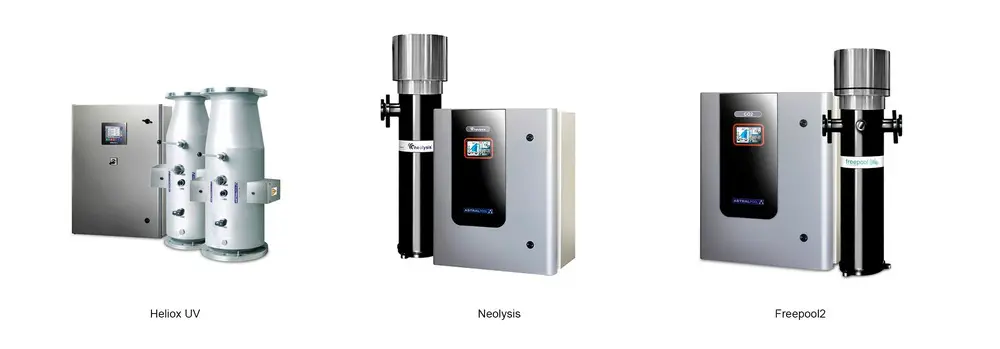There are many ways to treat a swimming pool to get the best water quality possible. Adding chlorine is one of the most common methods to disinfect water. There are three categories of chlorine that pool operators should monitor: free chlorine, combined chlorine and total chlorine.
The quantities of each type determine the effectiveness of water disinfection, so understanding these metrics is key to maintaining clean and clear water. In this short guide, we’ll explain the differences and how to manage irregularities.
Dive deeper with the eBook
Free chlorine, combined chlorine and total chlorine
Free chlorine is chlorine in its virgin form. This means it hasn’t come into contact with any contaminants and is still available to disinfect the water. Generally, it’s what is usually tested to determine the proper chlorine levels in pool water. Free chlorine should be between 1.0 and 3.0 parts per million (ppm). Maintaining these levels will ensure good water quality.
When chlorine acts in the water, it comes in contact with dirt particles from different sources: dust from the air, leaves or particles blown by the wind, the sweat of bathers, skin oils, etc. This combination is what we call combined chlorine , also known as chloramines.
Once combined chlorine has formed, its ability to disinfect is limited. In a way, combined chlorine has already been “used” to sanitise the water. Combined chlorine is the source of the unpleasant chlorine smell and irritated eyes and skin that pool water can cause. In addition to causing discomfort and ineffective sanitisation, prolonged exposure to combined chlorine can lead to asthma, allergies and other health issues.
Lastly, total chlorine is simply the sum of the free and combined chlorine in the swimming pool water.
How do you treat combined chlorine?
Various water treatment solutions are available to manage chloramine levels in your swimming pool.
One option is to perform a process known as overdosing or super-chlorination. As we saw above, once combined chlorine has formed, its ability to disinfect is limited. Specifically, it takes 25 parts of combined chlorine to do the work of just one part of free chlorine. Once you know the level of combined chlorine in your pool, you will have to add about 10 times that amount of free chlorine to neutralise it.
However, there are more innovative and efficient alternatives. The best solution to treat this phenomenon is to integrate a state-of-the-art UV disinfection system such as Heliox UV , Neolysis or Freepool2 into your water treatment system.

UV light is a form of electromagnetic radiation used to treat residual, drinking and aquacultural water. In recent years, it has also been used to treat swimming pool water.
UV radiation systems such as Heliox UV lamps operate over a wide spectrum to eradicate chloramines (<0.6 ppm). This solution also neutralises 99.9% of microorganisms, including algae, bacteria, viruses, fungi, yeasts and other microorganisms resistant to chlorine treatment. Moreover, it minimises the need for chemical treatment, reducing the levels of combined chlorine and the need to renew pool water.
Neolysis uses UV technology alongside a low-salt chlorination combination in one reactor. Neolysis dramatically reduces the concentration of chloramines without the need for more chlorine, reducing odours and irritation. It also saves water and energy as it’s no longer necessary to backwash the filter to reduce chloramine levels.
Lastly, the Freepool2 system disinfects with a combination of salt electrolysis and UV lamps. The system also corrects pH levels by injecting CO2 through the same reactor, instead of acid. This reduces the number of harmful compounds derived from mixing with organic substances. The process is also beneficial to the environment by reducing gas emissions from facilities without affecting water quality.
A final thought
Although not a water treatment system that directly regulates pool parameters, pool covers are another solution to reduce combined chlorine levels by preventing external debris particles from falling into the pool water.
As such, there are fewer substances able to form the combined chlorine. Together, a system such as those described here along with a pool cover can dramatically reduce the chloramine levels in your pool.
